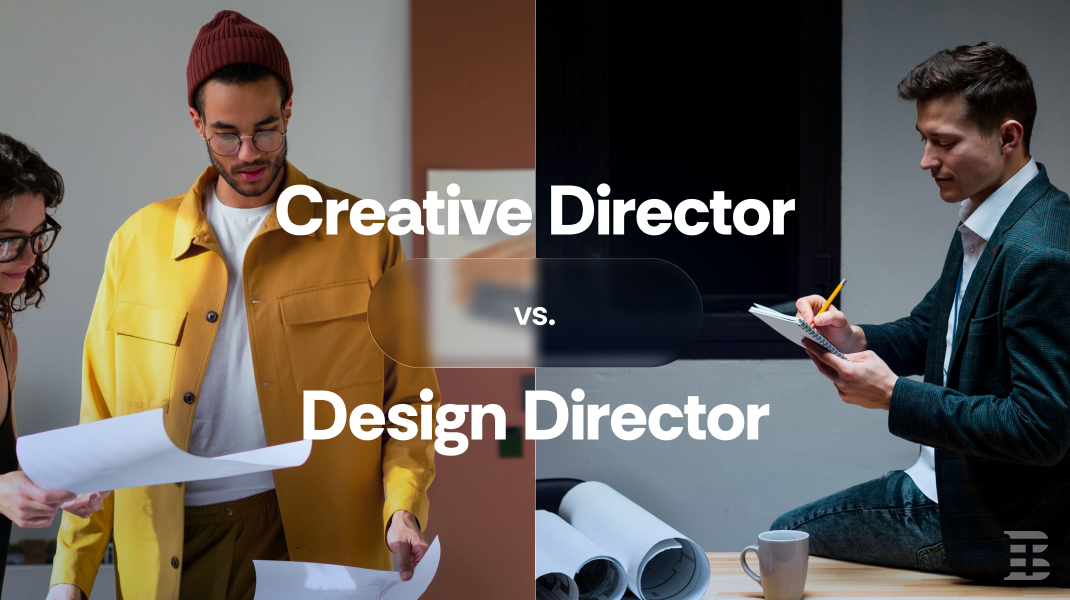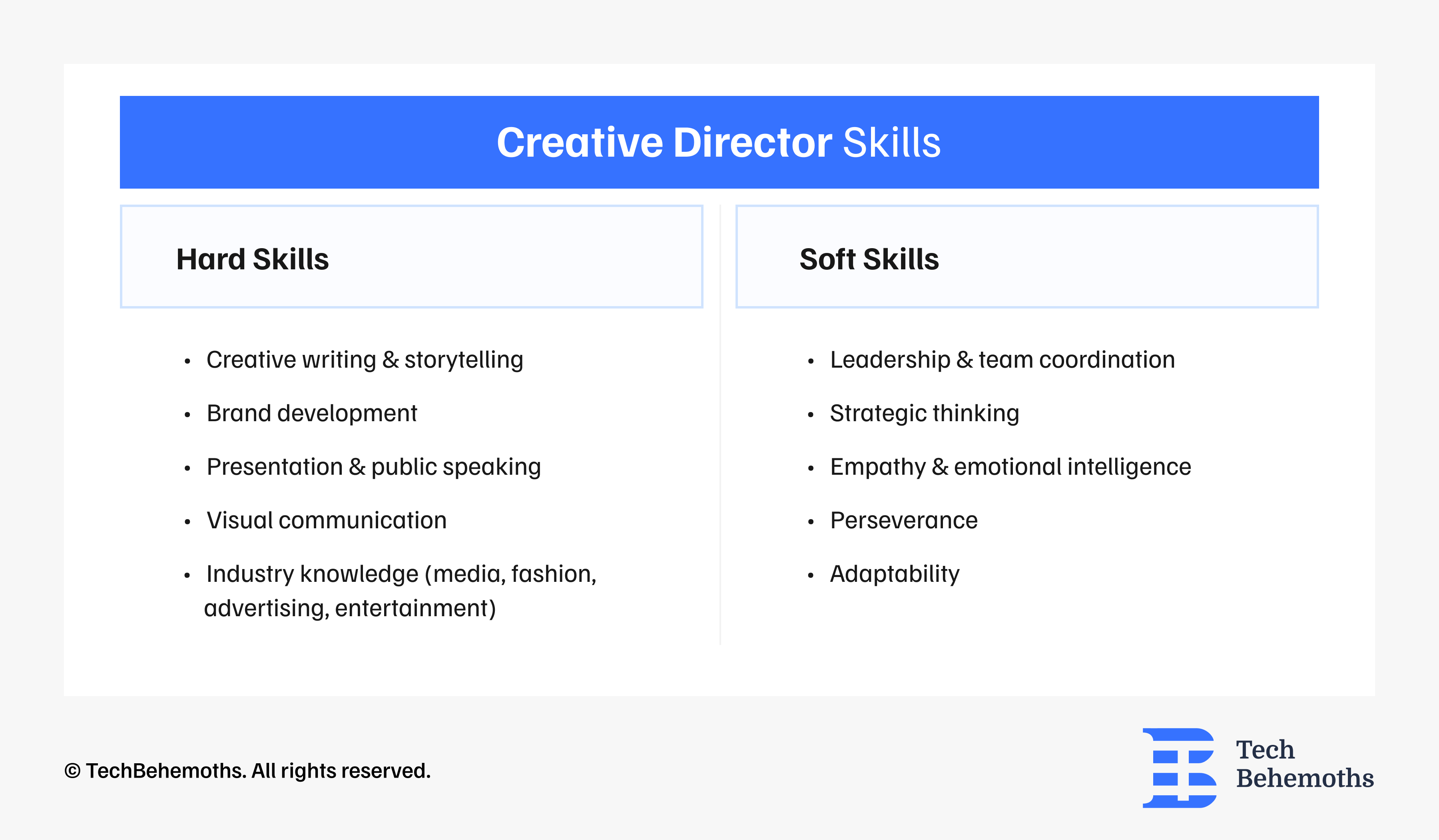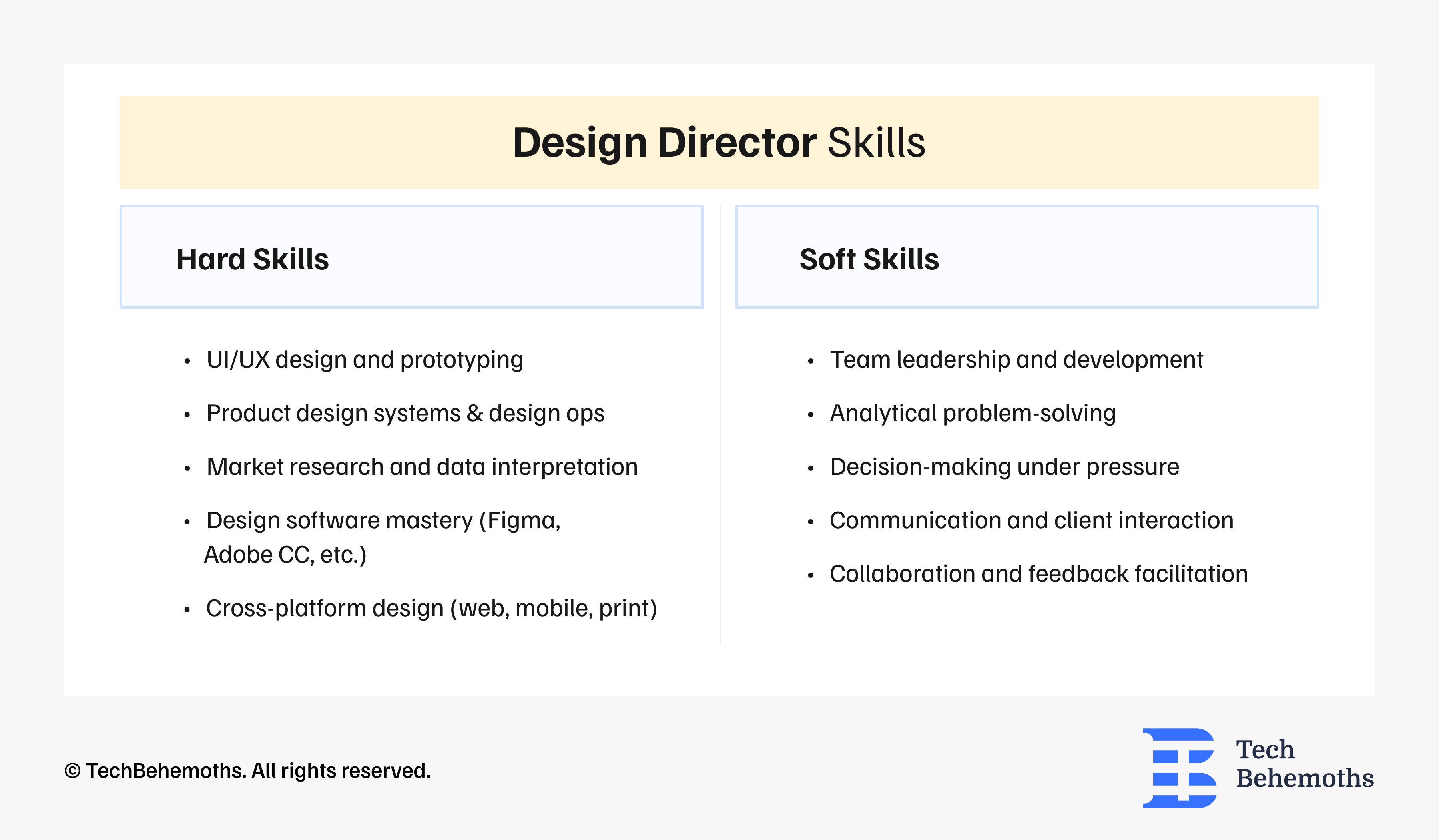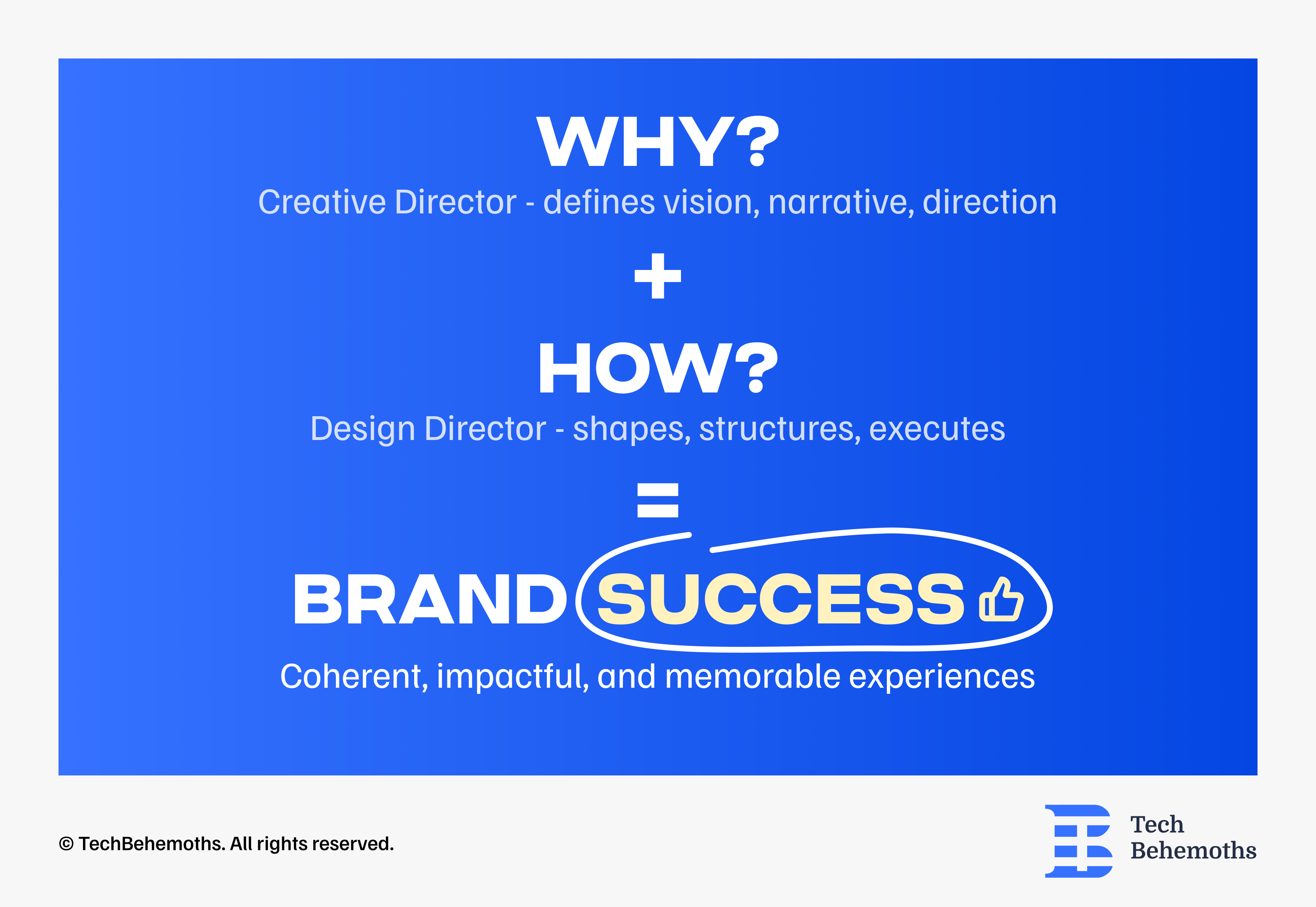Creative Director vs. Design Director: Which One Does Your Business Need?

Summary
- Creative Director shapes the brand’s vision, storytelling, and emotional impact across campaigns and media. Design Director turns that vision into functional, user-friendly designs, managing teams and execution quality.
- Their collaboration consists of the Creative Director establishing the "why" - the vision, the concept, the narrative, and the Design Director taking care of the "how" - the implementation, quality, and usability, but also having clear differences and responsibilities that do not overlap.
- Choose Creative Directors for brand-building and marketing; Design Directors for product scaling and design consistency.
Design leadership is what will drive how memorable your brand identity will be from launch to maturity, as well as how well-crafted your final digital products will be for your future consumers. Unfortunately, many tech players struggle to define and separate these two roles: Creative Director and Design Director, which creates confusion because they appear to be doing the same thing when, in fact, they are not, leading to mis-hiring, unclear expectations, and ultimately poor results.
In this article, we’ll break down the roles of Creative Director and Design Director, explore where they overlap, and help you decide which one is right for your project. You’ll also discover how the agencies on TechBehemoths provide access to these leadership roles, without having to hire in-house.
Who Does What: A Practical Guide to Creative Roles
Creative Director and Design Director - both operate at the intersection of design and strategy, but their skill sets, responsibilities, and impact on your project are quite different. Regardless of whether you're a startup founder, marketing leader, or someone looking to collaborate with a top design firm, these differences need to be well understood in order to make the right creative decisions. Let's now go through in detail what each of them represents.
a. What Does a Creative Director Do?
A Creative Director is the visionary force behind a brand’s communications. They are responsible for coordinating and overseeing the visual direction of a creative project, whether it’s advertising, graphic design, video production, film production, or video game development.
Creative Directors establish the look, feel, structure, and emotional tone of a campaign, product, or other type of creative project. They work closely with creative teams, such as graphic designers, web developers, copywriters, art directors, photographers, etc., to ensure visual coherence and the desired impact of the project.
In short, Creative Directors operate at the highest level of storytelling – shaping ideas from concept to delivery.
Common Responsibilities:
-
Defining the creative vision and narrative direction
-
Leading brand messaging and tone across all media
-
Overseeing the creative concept from ideation to execution
-
Presenting concepts and final products to clients or stakeholders
-
Collaborating with art directors, marketing teams, and executives
-
Providing critical feedback to ensure consistency and quality
Creative Director Skills

Common industries where the expertise of a creative director is required are: advertising and marketing agencies; branding studios; film, entertainment, gaming, publishing, and media.
b. What Does a Director of Design Do?
A Design Director coordinates with the executive side of the design process, meaning that while a Creative Director has the answer to the “why,” a Design Director is responsible for the “how.” They are the ones who ensure that the Creative Director’s or client’s vision is implemented into reality, in a user-centric manner, so that the idea becomes functional, attractive, and comfortable for future users of the product.
Therefore, the Design Director serves as a bridge between the company’s management and the design team, turning business objectives and client briefs into concrete design strategies, processes, and systems.
Common Responsibilities:
-
Building and mentoring a high-performing design team
-
Setting the visual standards, systems, and workflows
-
Translating creative briefs into executable design strategies
-
Integrating user research and market trends into design choices
-
Ensuring alignment between design execution and business goals
-
Managing timelines, budgets, and delivery across multiple media
Design Director Skills

The industries where the contribution of a design director is most often required are: SaaS and software development, product design agencies, technology startups, digital platforms and marketplaces, and corporate innovation teams.
Key Differences Between the Two Roles
|
Aspect |
Creative Director |
Design Director |
|---|---|---|
|
Primary Focus |
Brand strategy, storytelling, vision |
Execution, systems, product usability |
|
Scope of Work |
Marketing campaigns, content, advertising, branding |
UX/UI, product interfaces, interaction design |
|
Key Deliverables |
Creative concepts, brand narratives, campaign messaging |
Design systems, prototypes, wireframes, design assets |
|
Team Oversight |
Creative professionals (copywriters, photographers, art directors) |
Designers (UX/UI, product, graphic), researchers, dev collaborators |
|
Collaboration With |
Marketing execs, clients, brand stakeholders |
Product managers, engineers, UX researchers |
|
Typical Output |
Emotionally resonant, persuasive visual content |
User-friendly, scalable, efficient design solutions |
|
Leadership Type |
Visionary and storytelling-oriented |
Operational and performance-oriented |
|
Industries |
Advertising, film, media, branding agencies |
Tech, SaaS, digital products, design studios |
|
Hourly Pay (Estimates) |
$70–$150/hour (freelance or external consultant rates) |
$65–$130/hour (freelance or external consultant rates) |
Where They Overlap and Collaborate
The collaboration between the Creative Director and the Design Director is based on the complementarity of their roles, but there are also clear areas where they do not intersect, all of which we will analyze in this chapter.
Regarding how these two collaborate, the Creative Director sets the creative vision and overall strategy of the brand or project, develops the artistic concept, establishes the overall creative direction, and ensures that all initiatives reflect the desired image and business objectives. Therefore, the Design Director takes this vision and transforms it into practical results, managing the daily process of the design team, translating creative ideas into functional and qualitative solutions, ensuring the efficiency of execution and proximity to the standards and vision of the Creative Director.

Areas of collaboration and overlap:
-
Both assume the role of a leader who coordinates teams and collaborates to ensure coherence of creative outputs in relation to the brand.
-
The Creative Director is the person who provides direction and approves concepts, and the Design Director implements them, taking responsibility for optimizing execution.
-
Communication is essential for translating conceptual ideas into final products that meet deadlines and budgets.
Clear areas without intersection:
-
The Creative Director does not deal with the daily details of implementation and the specific management of the design process.
-
The Design Director is not responsible for formulating the creative strategy or the brand message, but focuses on the technical and qualitative side of the design.
Thus, the relationship is one of complementarity: The Creative Director “dreams up” and develops the artistic strategy, while the Design Director “realizes” this strategy by managing the design process and ensuring visual and functional quality.
Creative Director vs. Design Director: Which One Does Your Business Need?
Let's start by saying that it's not about which role is "better" when choosing between a Creative Director and a Design Director, but about which one your business needs right now. Each role serves a distinct purpose, depending on where your company is in its growth journey and the type of results you want - whether it's launching a bold brand, scaling a product team, or increasing visual performance.
The table below outlines when and why each role becomes essential:
|
Business Context |
You need a Creative Director if… |
You need a Design Director if… |
|---|---|---|
|
Early-stage startup |
You're building a brand from scratch and need a strong vision, storytelling, and positioning |
Not essential yet, design tasks are minimal and manageable by a small team |
|
Growing startup |
You’re launching campaigns, increasing visibility, and need bold, differentiating creative concepts |
You're scaling your product and have multiple designers or visual outputs to manage |
|
Rebranding or repositioning |
You're redefining how your brand is perceived and expressed |
You need to optimize how the visual direction is implemented across all touchpoints |
|
Digital product (SaaS, app, platform) |
You want the product to feel unique and emotionally engaging |
You need scalable, consistent UI/UX design and a strong design system |
|
Marketing & advertising campaigns |
You're focused on big ideas, visual storytelling, and campaign-level creative direction |
Less critical, execution can be handled under the creative vision already set |
|
E-commerce or website scaling |
You need creative direction for tone of voice, visual branding, and customer emotion |
You need strong design consistency, UX optimization, and scalable assets |
|
Expanding the design team |
You want all creative areas (design, video, content) to align under one brand vision |
You're managing 3 or 5+ designers and need clear workflows, quality control, and design ops |
|
Creative stagnation |
Your brand feels dull or uninspired and needs a fresh, creative direction |
Less useful, creative strategy should come first before optimizing execution |
|
Priority is innovation |
You’re aiming to stand out through bold ideas, emotional storytelling, and visual uniqueness |
Helpful, but not essential; innovation stems from conceptual creativity, not execution |
|
Priority is consistency and efficiency |
Not ideal - Creative Directors often push constant change and experimentation |
Essential - a Design Director ensures structure, clarity, and alignment across all outputs |
How Agencies on TechBehemoths Deliver These Services
Finding the right agency to shape your brand or improve your product design isn’t always easy. On TechBehemoths, you can directly contact agencies that don’t just list services - they actually offer branding and identity services, UI/UX design, and large-scale creative and digital projects.
You’ll find examples of real work, not buzzwords. It’s worth noting that each profile includes verified client feedback, public portfolios that show how they think and work, and enough detail to assess the quality behind the visuals.
For those just starting out in business, as well as companies that have already established a foothold in the market but want to expand, the platform lets you filter by what matters to you at that stage: budget, industry, location, and technology expertise, taking the guesswork out of it and instead offering smart filtering and transparency.
Looking for expert design and branding agencies?
Explore the best product design partners, digital strategy experts, and creative branding agencies, and more on TechBehemoths – sorted by expertise, industry focus, and client feedback.
Conclusion
As previously clarified in the article above, the choice between a Creative Director and a Design Director depends on the goals of your business.
The difference is that the former focuses on the overall brand vision, storytelling and campaign direction - ideal if you are building a brand, running marketing campaigns or launching a rebranding, while the latter - the Design Director ensures high-quality execution with a meticulous and measurable approach, managing design teams, systems and product interfaces - inevitably important for companies developing digital products and beyond.
So, both roles are leadership positions; the Creative Director thinks through the message, and the Design Director ensures that the message is conveyed through a perfect design and in line with user expectations.
With all that being said, I encourage each of us to look at and perceive these roles not just as simple job titles, but as valuable people needed in any creative team, who directly influence the success of your projects, but also the value of your company.
Related Questions & Answers
How much does the average salary of a Creative Director and Design Director differ?
Can a Creative Director be a Design Director at the same time?
Which role is more likely to interact with the CEO or board members?
How will the level of creative risk-taking affect the success of companies in 2025?
How are these roles evolving with emerging technology (e.g. AI, AR/VR)?